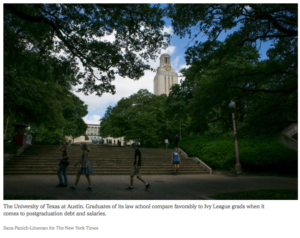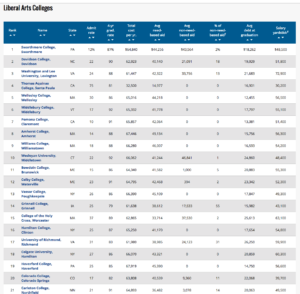By ELIZABETH OLSON, New York Times – JAN. 24, 2017

More law school graduates, laden with six-figure debt, have been questioning whether their investment in a degree that comes with such a hefty tuition price tag pays off with a highly paid job.
Elite institutions are generally worth the outlay, but, according to a newly released study, a few less nationally known schools also make the cut.
The University of Texas at Austin, the University of Houston and the University of Georgia were among the 10 schools offering the best salary-to-debt ratios, according to the study by SoFi, which stands for Social Finance Inc., an online student loan refinance company. They are grouped with Harvard, Yale and Stanford among the top schools that offered their graduates good value for the substantial debt they incurred while law students.
SoFi rated the schools after examining salary and debt records of more than 60,000 people who applied to refinance their student loans with the San Francisco company between 2014 and 2016.
A University of Texas law graduate, for example, had an average debt of $105,254 but three years after graduation earned an average $147,444, or 1.4 times the debt incurred. That is the same ratio that a Yale Law School graduate has, according to SoFi data. On average, graduates of Yale Law School, which is ranked the No. 1 law school nationally, have $123,793 in debt and earn a salary of $171,779, according to the SoFi report called “Return on Education (ROED) Law School Rankings.”
The Ivy League school offers financial aid packages, and about 60 percent of the law school’s students qualify for need-based scholarship grants, according to SoFi’s findings.
Texas graduates have the advantage of low tuition costs, said Amanda Wood, SoFi’s director of business operations and strategy. The tuition is $34,000 a year, the second-lowest in-state tuition among the country’s top 20 ranked schools, according to the study. The Texas school has a national ranking of No. 15.
Another Texas school, the University of Houston, had a similar salary-to-debt ratio, Ms. Wood noted. The average graduate from that school three years out had $100,160 in debt and earned an average $136,370.
Over all, typical law student loan debt is estimated to be in the low to mid six digits for private law school students, and lower for those who attended public institutions. However, no one official figure covers all law schools.
The SoFi study points out that graduates with well-paid jobs and good credit can typically refinance their student loans at a lower rate. However, refinancing with a private lender eliminates protections such as income-based repayment plans and loan forgiveness for those in public service jobs.
For those seeking a great law school deal, the best may be Brigham Young University, where the average debt is $68,873 and graduates, many of whom stay and practice law in Utah, earn an average of $108,916. But not everyone can qualify. Tuition costs are exceptionally low for members of the Church of Jesus Christ of Latter-day Saints, but non-Mormons pay double the $12,000 annual tuition, Ms. Wood said.
At the opposite end of the spectrum, SoFi also listed the worst law schools for salary-to-debt ratio, including Florida Coastal School of Law, Charlotte School of Law and Arizona Summit Law School, all three of which are for-profit schools owned by Infilaw Holdings, in Naples, Fla. At two schools, students ran up more than $150,000 in student debt but earned, three years after graduation, slightly over $84,000. Only Arizona Summit, which was formerly known as Phoenix School of Law, had graduates with average annual earnings of slightly over $96,000 — but that came with debt exceeding $155,000.
Infilaw did not respond to a request for comment.
Other law schools that graduated newly minted lawyers who earned modest salaries but carried heavy debt loads — approximately 1.5 times as much as annual salary — included St. Thomas University, Appalachian School of Law, Thomas Jefferson School of Law and Elon University, SoFi found. Hefty debt means large portions of recent graduates’ paychecks go toward paying off student loans.
Taking into account salary only, graduates of three prestigious law schools — Columbia University, Cornell University and New York University — earned average salaries above $175,000 three years after getting their degrees, according to SoFi’s data.
Those salaries are “just one or two raises away from the Bureau of Labor Statistics’ best-paid lawyer salary of $187,200,” said Ms. Wood, who also noted that the top three schools are all in New York. That finding, she said, “reinforces the idea that location matters when it comes to earning potential.”

